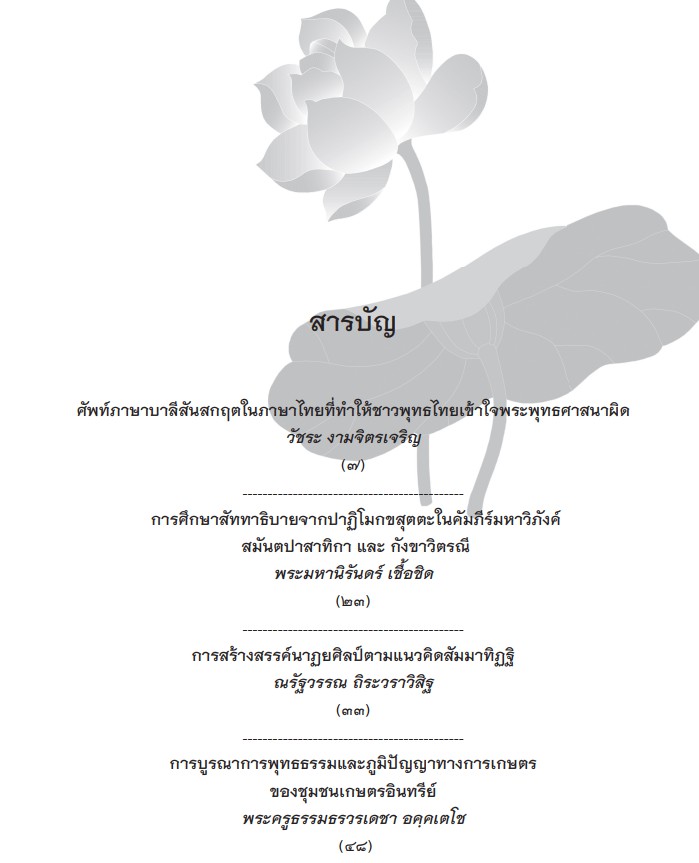A Study of the Explanation of Pāṭimokkhasutta in Mahāvibhaṅga, Samantapāsadikā, and Kaṅkhāvitaraṇī
Keywords:
Pāṭimokkhasutta, Padabhājanīya, Mahāvibhaṅga, Samantapāsadikā, KaṅkhāvitaraṇīAbstract
This is a comparative study of the explanation of 150 monastic rules (Pāṭimokkha) called Padabhājanīya in Mahāvibhaṅga, Samantapāsadikā and Kaṅkhāvitaraṇī. The researcher focuses in particular on the methods of explaining words or phrases in monastic rules for male and/or female monks in Mahāvibhaṅga. The study finds that the explanations in the three scriptures have similar forms: they are sequential explanations of phrases without focusing on each and every work. In Padabhājanīya, ‘Nāma’ and ‘Iti’ are used following explanations of words or pharses, with ‘Nāma’ being more frequently used. Synonyms and similes are also used in elaborations. In Samantapāsadikā, ‘Nāma’ and ‘Iti’ are also used following explanations of words or pharses, but with ‘Iti’ being more frequently used than ‘Nāma’. Only synonyms are employed in explanations here. In Kaṅkhāvitaraṇī, ‘Ādi’ is used in synopses and in references to relevant scriptures for further studies.
Downloads
References
จำรูญ ธรรมดา ๒๕๕๕“กระบวนการตีความพระพุทธพจน์ตามแนวของคัมภีร์เนตติ,” พิมพ์ครั้งที่ ๑ กรุงเทพมหานคร:ประยูร สาสน์ไทย.
พระไตรปิฎกบาลีวินัยปิฎก เล่มที่ ๑-๒ อักษรไทยฉบับสยามรัฐ. ๒๕๐๐.กรุงเทพฯ:โรงพิมพ์มหาจุฬาลงกรณราชวิทยาลัย.
พระไตรปิฎกภาษาไทยฉบับหลวง. ๒๕๐๐. กรุงเทพฯ:โรงพิมพ์มหาจุฬาลงกรณราชวิทยาลัย.
พระพุทธโฆษาจารย์. ๒๕๓๔. สมนฺตปาสาทิกา นาม วินยฏฺฐกถา ปฐโม ภาโค. กรุงเทพฯ:โรงพิมพ์วิญญาณ.
พระพุทธโฆษาจารย์. ๒๕๓๔. สมนฺตปาสาทิกา นาม วินยฏฺฐกถา ทุติโย ภาโค. กรุงเทพฯ:โรงพิมพ์วิญญาณ.
พระภัททันตมหาพุทธโฆษะ.๒๕๓๙. กงฺขาวิตรณีอฏฺฐกถา. กรุงเทพฯ:โรงพิมพ์วิญญาณ.
Hinüber, Oskar Von. 2000. A Handbook of Pāli Literature. New York: Walter de Gruyter.
Norman, K. R. 1983. Pali Literature. Wiesbaden: Harrassowitz.
Downloads
Published
How to Cite
Issue
Section
License
บทความที่ได้รับการตีพิมพ์เป็นลิขสิทธิ์ของศูนย์พุทธศาสน์ จุฬาลงกรณ์มหาวิทยาลัย
ข้อความที่ปรากฏในบทความแต่ละเรื่องในวารสารวิชาการเล่มนี้เป็นความคิดเห็นส่วนตัวของผู้เขียนแต่ละท่านไม่เกี่ยวข้องกับศูนย์พุทธศาสน์ จุฬาลงกรณ์มหาวิทยาลัย และคณาจารย์ท่านอื่นๆในมหาวิทยาลัยฯ แต่อย่างใด ความรับผิดชอบองค์ประกอบทั้งหมดของบทความแต่ละเรื่องเป็นของผู้เขียนแต่ละท่าน หากมีความผิดพลาดใดๆ ผู้เขียนแต่ละท่านจะรับผิดชอบบทความของตนเองแต่ผู้เดียว






